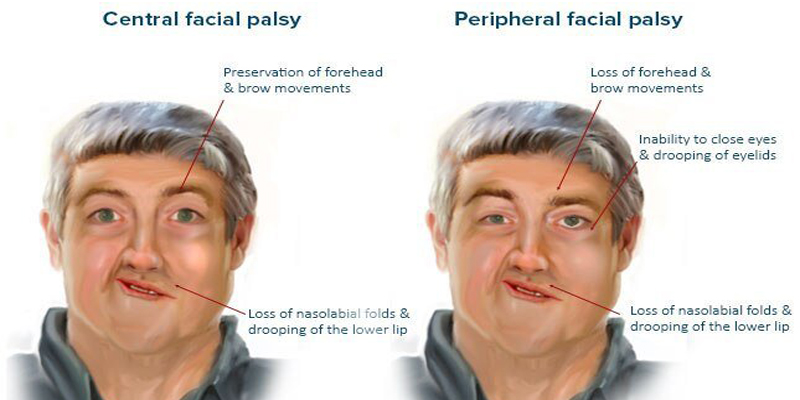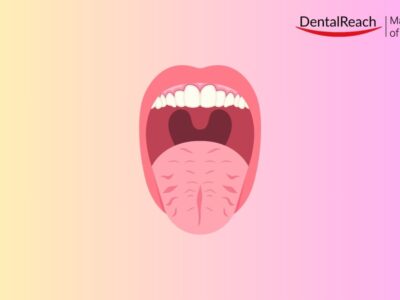Covid-19 and the existing nervousness
Covid-19 related lockdowns were observed in many countries. These lockdowns created mental instability, with most of the population experiencing a loss of career or livelihood. Due to the unexpected anxiety and stress, a case of idiopathic facial paralysis was discovered in France. Rare cases of the same, as a temporary after effect of the Covid vaccine, has also been reported in a few countries.
Facial Paralysis & Covid-19
A 49 year old French chef, on April 6th 2020, suffered painless acute right facial paralysis condition mainly due to the unrest in his professional career, which before the pandemic was very much in an excellent condition.
On physical examination, the patient showed a complete right sided peripheral facial paralysis with House- Brackmann classification showing grade V impairment. The patient’s consciousness and motor coordination were excellent. There were no signs of ataxia and other neurological disturbances. The patient was given a diagnosis of idiopathic facial paralysis, as he had mentioned a similar type of temporary episode few years back, and advised Prednisone 1mg/kg daily single dose with Valaciclovir, 1000mg thrice daily for ten days.
The patient was continuously followed up and he presented with severe symptoms of right sided pressing occipital and hemicranial pain from past 5 days with pericranial tenderness and trigger points over right trapezius muscles, indicating an episodic tensional type of an headache. It was managed by Codeine. Patient also had sudden episodes of psoriatic episodes over the arms. The facial paralysis did not seem to show any improvements. Further on discussion, patient revealed severe anxiety associated with his diminishing career because of Covid-19 pandemic. He was surely going to lose his employment due to the lockdown implementation post pandemic, and was extremely uncertain about his future aspects.
About Bell’s Palsy
The inflammation of the fallopian canal, a small bony tube enveloping the facial nerve, leads to a clinical condition known as Bell’s palsy. Seventh Cranial nerve is situated inside an extremely narrow canal, thereby the condition basically develops due to compression of the nerve. The face consists of fascia, facial muscles and subcutaneous tissues. The facial muscles have their origin from different site and most of the facial muscles get their nerve supply from the facial nerve. the muscles of facial expressions directly insert into the facial skin therefore contraction of these muscles will move the skin.
Bell’s palsy is a temporary condition that restricts the nerve impulses transmission from the muscle to the brain, causing muscle weakness or paralysis. The facial muscles, unlike other skeletal muscles, do not go for permanent atrophy even after years of lack of function. The VII cranial nerve is a part of cranial nerve which are dispersed over the face. Hence it is very clear that only it being non functional will not affect the action or moving of the facial muscles as these muscles, will be controlled by other cranial nerves.
Causes of Bell’s Palsy
- Herpes simplex viral infection : It was in 1970, Dr Kedar Adour suggested HSV to be associated with Bell’s Palsy. In 1995, Dr Shingo Murakami pointed HSV to be the main leading factor for the development of Bell’s Palsy.
- Other viral links : Research has also shown the association of Cytomegalovirus, Epstein Barr, rubella and mumps virus with Bell’s palsy.
- HIV/AIDS : HIV can lead to the development of facial paralysis, thereby increases the chances of Ramsay Hunt syndrome and Bells Palsy.
- Bacterial infections : Lyme Disease and Otitis media can cause facial paralysis and presents with similar symptoms of Bells Palsy.
- Melkersson Rosenthal syndrome: This condition may result in unilateral or bilateral facial paralysis.
- Other causes: Facial wounds, trauma due to blunt objects, acoustic neuroma, skull bone fractures especially temporal bone, brain stem injuries, lupus, Sjogrens syndrome, Diabetes etc.
Clinical symptoms of Bell’s palsy
The onset of Bell’s palsy is sudden but symptoms can worsen during the early period. Its symptoms may be in peak within few days, but it may take as long as two weeks in few individuals. If the paralysis becomes slowly visible, then tests for other conditions needs to be done.
Psychologically, the condition will show a devastating situation, particularly with patients showing longer clinical period of the disease. Family, friends and doctor may have no clue that the affected patients may be deeply saddened because of lost self esteem.
Symtoms include –
- Muscles show weakness and paralysis, forehead wrinkles disappear.
- Overall droopy appearance of the eye lid shows difficulty to blink.
- Stuffy nose
- Difficulty to speak, eat and drink
- Pain in the ear or drooling
- Sensitivity to noise (hyperacusis)
- Excessive or reduced salivation with altered taste sensation
- Difficulty to close the eyelids with lack of tears
- Sensitivity to light
Following these clinical symptoms, a patient with Bells palsy will recover spontaneously from the disease within three months with no physical treatment delivered.
Diagnosis
After taking a through history and clinical examination, depending on the symptoms various tests like CT of the brain and MRI can be suggested to the patient. These tests will add a conviction to the diagnosis of Bells Palsy or provide other needed information for the other diagnosis.
Treatment
The first priority in the treatment of any nerve injury related disorders is to identify the source of injury as early as possible. Narrow canals will trigger mild nerve compressions, but if this condition persists for a longer period then it may result in a generously proportioned damage of the cranial nerve. Medications that may release the compressions like prednisone or antiviral may be started within a window period of seven days after the onset of the symptoms of Bell’s palsy. Rest is very important during this condition.
Food particles may be stuck between the gums and teeth so extra efforts must be taken to clear the food debris. Protective eye wears need to be worn to prevent dry eyes and keeping them moist with the use of Lacrilube, Visco tears, and Hypo tears gels. In case of hyper sensitivity to loud noise, usage of ear plugs will provide a sense of relief to the patient.
Care must be taken not to start with immediate facial muscle exercises. Since this condition is reversible, immediate provocation of flaccid muscles will lead to synkenitic movements of the facial muscles. The facial muscles will get their nerve impulses slowly. Thus when a patients discovers the recovering nerve signals, then gentle tapping or massaging the area around the muscles will improvement the condition.
Medicines used to treat Bell’s Palsy
- Steroids: 20mg of Prednisone is most commonly advised systemic drug as a first line of treatment for Bell’s palsy.
- Antiviral drugs: Famciclovir , Acyclovir and Valacyclovir are the drugs used for the faster results against Bells palsy.
- Multivitamins: Vitamins like B-complex especially Methylcobalamine is an important factor for nerve regeneration and provides faster recovery from Bells palsy.
References
- Heckmann JG. The diagnosis and treatment of Idiopathic facial paresis (Bell’s palsy). Dtsch Arztebl Int 2019;116:692-702.
- Margaux Fricain. Lockdown-related idiopathic facial paralysis. J Oral Med Surg 2020; 26:39.
- Mackolil J. Addressing psycho-social problems associated with covid 19 lockdown. Asian J Psychiatr 2020; 51:102156.
- Zhang W. The Etiology of Bell’s Palsy: a review. J Neurol 2020; 267:1896-1905.
- Li J, Yang Z. Anxiety and depression among general population in china at the peak of COVID 19 epidemic. World psychiatry 2020; 19:249-250.
- Yao H. The more exposure to media information about COVID 19, the more distressed you will feel. Brain Behav Immun 2020;87:167-169.
FAQs on Facial Paralysis Due to Stress
-
Can stress really cause facial paralysis?
Yes, stress can trigger facial paralysis in certain cases. Stress can impact the body’s immune system and nervous system, potentially leading to conditions like Bell’s palsy, where facial muscles become weak or paralyzed. It’s important to manage stress to prevent such occurrences.
-
How does stress lead to facial paralysis?
Stress can weaken the immune system and cause inflammation of the facial nerves, which can result in facial paralysis. Additionally, stress might lead to behaviors like teeth clenching or muscle tension that contribute to nerve compression, further increasing the risk of facial paralysis.
-
What are the symptoms of facial paralysis caused by stress?
Facial paralysis due to stress can lead to symptoms like drooping of one side of the face, difficulty closing the eye on the affected side, altered sense of taste, and difficulty in smiling or making facial expressions. These symptoms can appear suddenly and worsen over a few days.
-
Can facial paralysis from stress be treated?
Yes, in many cases, facial paralysis caused by stress can be treated. Managing stress through relaxation techniques, exercise, therapy, and lifestyle changes can help alleviate symptoms. In addition, medical treatments like corticosteroids and antiviral medications might be prescribed by a healthcare professional to speed up recovery.
-
Is facial paralysis always due to stress?
No, facial paralysis can have various causes, and stress is just one of them. Other potential causes include viral infections (like the herpes simplex virus), trauma, tumors, and neurological conditions. A proper medical evaluation is crucial to determine the underlying cause and appropriate treatment for facial paralysis.




















Comments